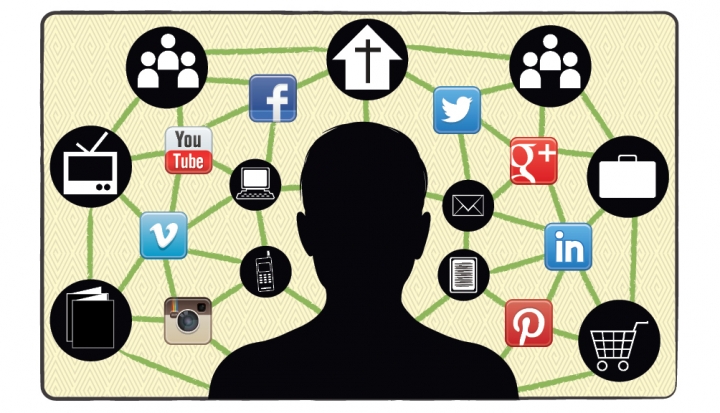It’s a familiar sight for anyone who has recently taken a bus or train, stood in a line, or waited for an event to start: Everyone scrolling through their phones, earbuds in, perhaps finishing up a call, sending a text message, or checking up on the latest news or sports scores. With advances in technology and the prevalence of social media, we have the opportunity to always be connected and plugged in to our devices. Is technology allowing us to expand our social networks, or are we prioritizing screen time over face-to-face time? Are there advantages to being tuned in, or are we just tuning out those around us?
For U.S. Catholic readers and website visitors, technology and social media, while sometimes a distraction, has mostly been useful in helping them to stay connected with friends and family, and often deepening their spirituality and prayer lives.
Many people even commented that they found their way to this survey through social media or that they took the survey on their smartphone. “I like that I was able to join in this discussion through my computer,” says Maureen Garvey of Deerfield, Illinois. “For just these kinds of things, social media is wonderful.”
In spite of an always changing technological landscape, most survey takers, who fall between the ages of 46 and 65, are embracing what it has to offer. Ninety-four percent of respondents indicate using a laptop or desktop computer on a regular basis. A majority of respondents, 57 percent, have a smartphone, while another quarter of respondents use a regular cell phone.
The most popular activity while using various devices is checking and sending e-mail, used by a full 99 percent of respondents. “You can do it on your own time and people can reply when they have time,” says South St. Paul, Minnesota resident Joyce Athmann of the convenience of e-mail.
Two-thirds of readers indicate that they use Facebook, while 59 percent say that they send and receive text messages. Seventy-one percent need to use technology and social media for work, while 83 percent say that their technological devices and online media tools help them keep up on news and current events.
Many respondents do not fit the stereotype that people are inseperable from their devices in today’s society. “I do leave my phone behind or off when I don’t think I’ll need it,” says Elizabeth Begley of Suffern, New York. More than half of survey takers estimate that they spend less than three hours a day having serious screen time with their various technological devices. Still more note that their phones are used only for emergencies, as opposed to everyday communication. “I take it with me but most often leave it in the car. I never take it into stores or restaurants,” says Cindy Trainque of Leominster, Massachusetts.
It appears that U.S. Catholic readers are able to exert plenty of control over their usage of technology and social media. Only 15 percent of survey takers agree that they have a hard time putting down their phone in social situations. Says Jeanette Hall of Fairland, Indiana, “I tell myself, ‘I own the phone—it doesn’t own me!’ I answer when I feel like it and never in a social setting. How rude!”
For some, there is more of a necessitiy to use various devices. “My smartphone is my only computer and camera,” says Cindy Engler of St. Louis Park, Minnesota. However, many people in today’s culture lament that this feeling of necessity causes us to lose the ability to interact with other people.
“I have a deep concern about the impact that Facebook, Twitter, and texting are having on our culture,” says Maureen Otremba of Sartell, Minnesota. “Young people often seem incapable of attending to people in their presence, as they are constantly checking their phones. The effect on interpersonal communication is quite negative.”
For U.S. Catholic readers, the main function of technology is actually to keep in touch and maintain relationships with other people. Seventy-seven percent agree that in general, social media has helped them stay more connected to friends and family, while nearly 90 percent say that their primary use for social media is to stay in touch with friends and family.
Says Jeanie Lewis of Chicago, “I am better friends with my sister-in-law and niece because I can message them photos and little bits of life updates.” Tom Rinkoski of Gainesville, Florida agrees. “As a proud grandparent, I do not know what I would do without Skype or Facebook,” he says. “I am so grateful that my children post pictures of the kids and family activities on Facebook. We use Skype for family conversations.” For some, without technology, connections would have been lost. “I have been able to reconnect with former friends that I had lost touch with,” says Martha Tribbey of Clarksville, Indiana.
Survey respondents are not necessarily more likely to use electronic communication than traditional methods, with 57 percent disagreeing that because of the ease and access to technology such as e-mail and Facebook they are less likely to call or visit someone in person. For some, it’s a matter of distance and practicality. One Utah resident describes his strategy: “I use e-mail to maintain contact with family and friends who live far away. I call or drop in on those who live nearby.” And there’s just nothing that can beat a handwritten note: 60 percent agree that a note in the mail means more than an e-mail with a similar message would.
Readers are not only using social media and advances in technology to keep in touch, but also to develop stronger connections both to their personal prayer lives and their parishes. Almost 60 percent indicate that they have used apps or other online tools to help with prayer.
One Toronto native lists some of the ways she uses media to connect to prayer: “YouTube for the rosary, the Chaplet of Divine Mercy, and sacred music. I search Google for prayers and information on matters of faith.” Diane Sirois of Rio Rancho, New Mexico says, “I read a daily meditation on my smartphone.” However, not all people find technology to be a useful prayer tool. “It takes away from my time completely alone with God,” says James Boardman of St. Joseph, Michigan.
Social media has also affected the way parishes interact with youth and young adults. “I work in youth ministry, so the teens I work with can be easily contacted via social media or texting,” says Kate Tyler of Dubuque, Iowa. Deacon Dan Donnelly of Manchester, Missouri has noted the same thing, though he sees areas for improvement. “The youth group uses Facebook extensively, but the rest of the parish is not up to speed on social media,” he says.
For some people, their parishes are on the pulse of the latest technology, through homilies posted on YouTube, the use of mobile apps, live broadcasts of Masses, and e-mail updates. About 85 percent of respondents indicate that their parish has a website, but very few use tools such as online forums, blogs, or discussions. Only 14 percent say their pastor uses Facebook or Twitter; however, 73 percent of survey takers agree that priests and bishops should be using social media to interact with parishioners. “Even though I don’t do much with my own Facebook account, I know that many people visit the site regularly, so I suggested that my parish start a Facebook page,” says Ann Lusch of Redford, Michigan. “The church needs to reach out to people where they are.”
People may be taking advantage of the opportunities that social media provides, but many readers know how much screen time is too much, and most know they really can live without it. Some, like Joseph Komadina of St. Louis, have no problem monitoring their use of technology. “I just disconnect at will,” he says. “If I don’t want to answer the phone, turn on a radio or TV, or connect to the Internet, I don’t.”
Forty-one percent of respondents say they have taken a deliberate fast from a certain type of online media. “I gave up Facebook for Lent last year. It was the best thing I ever did for myself,” says Julie Kelemen of Rice Lake, Wisconsin. She’s cut back her use of Facebook since then, but still says that it is often the only way to find out about certain news or events. “Groups that rely mostly or solely on Facebook to get out the word are choosing ease at the expense of thoroughness and inclusion,” she adds.
“Social media is not the problem,” says Stacie Adams of Perry, Kansas. “It is simply an extension of how we interact with one another, and it has allowed us to build a more complex and connected community. It is the world wide web.”
And the survey says…
1. The devices I use on a regular basis include:
94% – Laptop or desktop computer
57% – iPhone or other smartphone
35% – iPad or other tablet
28% – Kindle or other e-reader
25% – Cellular phone (not a smartphone)
14% – iPod or other music player
2. I have serious “screen time” with my technological devices for an average of ___ hours a day:
41% – 0-1
24% – 2-3
13% – 4-5
13% – 6-7
9% – More than 8
3. Social media has helped me to stay more connected with friends and family.
77% – Agree
17% – Disagree
6% – Other
4. I’m less likely to call or visit someone in person now that I can just send them an e-mail or contact them through Facebook.
36% – Agree
57% – Disagree
7% – Other
5. I have at some point deliberately undertaken a “fast” from certain online media.
41% – Agree
56% – Disagree
3% – Other
6. Access to technology and social media has helped me learn more about my faith and become more active in the church.
58% – Agree
37% – Disagree
5% – Other
7. More priests and bishops should use social media to interact with members of the church.
73% – Agree
16% – Disagree
11% – Other
Representative of “other”:
“I’d like to talk to my pastor in this way, but it could burden him.”
8. I typically use technology and social media for:
89% – Staying in touch with friends and family.
83% – Keeping up with news and current events.
71% – Work.
67% – Entertainment.
61% – Education.
50% – Prayer and spiritual reflection.
6% – Other
This article appeared in the July 2013 issue of U.S. Catholic (Vol. 78, No. 7, pages 31-34).
Image: Photo illustration by Angela Cox














Add comment